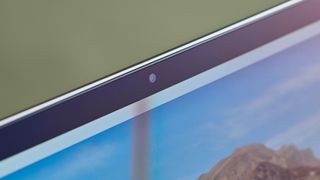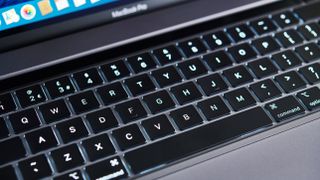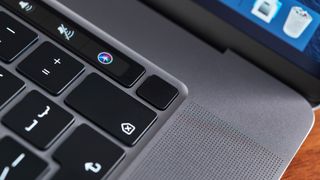16-inch MacBook Pro Design
At first glance, the 16-inch MacBook Pro doesn’t look all that different from the 15-inch model. That in itself is a remarkable achievement, considering the larger display the new MacBook Pro features.
Now the footprint of the MacBook Pro 16-inch is bigger than the 15-inch, with dimensions of 0.64 x 14.09 x 9.68 inches (1.62 x: 35.79 x 24.59cm) versus the 15-inch’s 0.61 x 13.75 x 9.48 inches (1.55 x 34.93 x 24.07cm; W x D x H), but it’s not enough to be that noticeable. It’s certainly impressive.
So, how did Apple manage this? On opening the MacBook Pro 16-inch, the answer is evident, with the bezels that surround the screen much thinner than previous models. Not only has this allowed Apple to fit a larger screen into the new MacBook Pro without drastically increasing the overall size of the laptop, but it makes the new MacBook Pro look and feel a lot more modern. It also ensures that all your attention is directed on that gorgeous screen.
And the screen – it really is a beauty. It’s the largest display on a MacBook since the MacBook Pro 17-inch was discontinued way back in 2012. It’s clear that Apple has heard feedback from its pro users that want a larger display, even at the expense of portability, and has acted.

We’re glad it has. Even with the larger display, Apple has made sure that image quality remains high, as it has also upped the resolution to 3,072 x 1,920. The result is a beautifully crisp display that looks sharp and vibrant. It’s not quite as pixel-packed as the Razer Blade 15 Studio Edition’s screen, which has a 4K resolution of 3,840 x 2,160.
The Razer Blade 15 Studio Edition’s screen is definitely the one to beat at the moment when it comes to pro laptops. It’s an OLED screen that’s factory calibrated and absolutely stunning. Not only does it beat the MacBook Pro 16-inch when it comes to resolution, but it’s also a touch screen as well.
Does that matter on a pro device? Well, one of the big selling points of the MacBook pro 16-inch, when we spoke to Apple, was how it runs macOS Catalina, which allows you to use an iPad as a second screen using the Sidecar feature. There are a number of creative apps that allow you to use the iPad along with the Apple Pencil stylus to control the apps via touch.
This is a great way of allowing creatives to interact with their tools in an intuitive way. However, it also requires an iPad – which is an additional expense. If the MacBook Pro came with a touchscreen, that wouldn’t be an issue. As Razer has shown, it’s indeed possible to include a touchscreen without compromising image quality – though there is a hit when it comes to price.

The keyboard has also been tweaked, thankfully replacing the Butterfly switches of previous models with the Scissor switch found in the popular iMac Magic Keyboard.
This should eliminate the problems that the Butterfly keyboards experienced (where keys became ‘stuck’ or unresponsive when dust or other debris found their way between the keys) – and in a recent teardown of the MacBook Pro 16-inch, iFixit found that Apple no longer includes a protective membrane underneath the keys, which it included in other recent MacBooks in a bid to fix the issues the Butterfly switches were encountering.
By not including the membrane, it appears that Apple is confident that the new keyboard of the MacBook Pro 16-inch will not have these problems.
The Scissor switches also allow the keyboard of the 16-inch MacBook Pro to have a decent amount of travel when the keys are pressed, while still keeping the MacBook Pro as slim as possible.
The result is immediately apparent: the MacBook Pro 16-inch’s new keyboard is a joy to type on, and a much more responsive and satisfying experience. When moving back to the older MacBook Pro 15-inch’s keyboard, it felt rather flat in comparison. We couldn’t wait to get back to using the newer keyboard. For anyone who does a lot of typing, the new and improved keyboard of the MacBook Pro 16-inch will be a huge selling point.
Further tweaks to the keyboard include shortening the Touch Bar and including a physical Esc key again. This might not be a big difference for a lot of people, but for many – especially coders – this will be a welcome change – and again shows that Apple has been listening to the requests of its customers.
